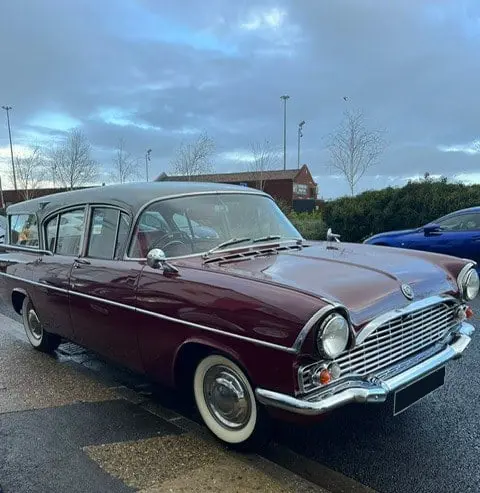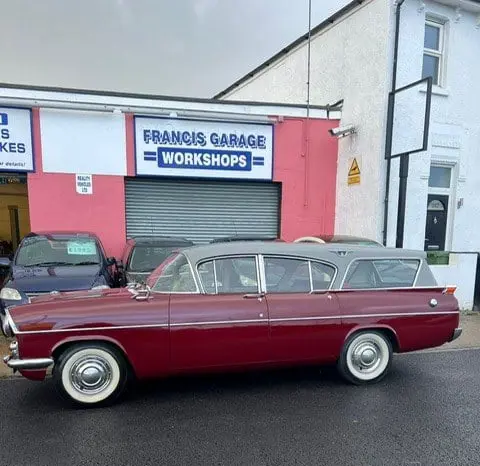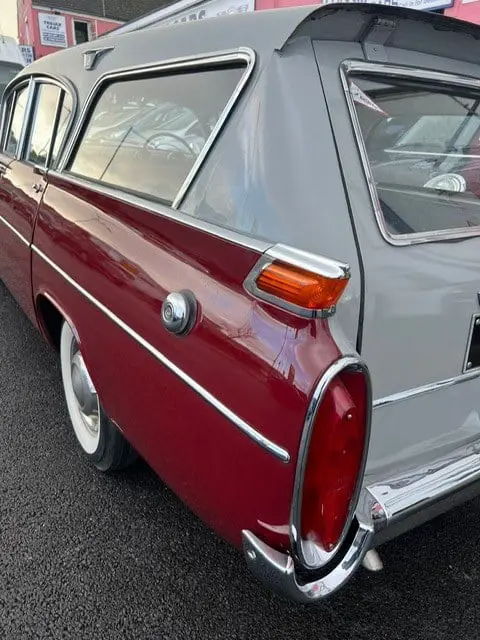RARER THAN RARE – VAUXHALL CRESTA PA FRIARY ESTATE
18 October 2024
For anyone whose off-duty tastes involve watching Expresso Bongo and playing (badly) the John Barry Seven’s Hit and Miss on their guitar, Trojan Cars of Southsea has the ideal vehicle. As it happens, this writer regularly indulges in both pastimes and finds himself sorely tempted by this 1960 Vauxhall Cresta PA Friary Estate.

The PA saloons made their bow in 1957 and, as with their E-Series predecessors, Vauxhall looked to external coachbuilders for the estate versions. The indispensable http://vauxpedianet.uk2sitebuilder.com/ notes they were:
factory approved and sold through all Vauxhall dealers. Vauxhall had already considered a factory produced Velox & Cresta Estate but deemed the market too small to justify the capital investment so instead passed the design drawings to Friary for their use in the version they ended up producing.
Peter Woodgate, the chief designer of E. D. Abbot of Farnham, devised the bodywork, but the brand was associated with Ford station wagons. The solution of the parent company, Friary Motors, was to acquire a factory near Basingstoke to avoid a conflict of interest.

The Friary Estates debuted in the spring of 1959, and your friendly local Vauxhall dealer could point out there was only a one-cwt weight penalty over the saloon. The bodywork was cleverly devised to allow 30 cubic feet of luggage space, even when the back seat was in place. Owners could also arrange the folded backrest to form a double bed from the 6ft 5ins load bay.
The Cresta’s price in 1960 was £1,309 – not cheap, but then who could put a price on such style. Motor Sport regarded the PA Friary as “an admirable tow-car, with enormous generosity of stowage and passenger space” and “a handsome vehicle” that could “fill a useful role in the motor racing firmament”. The Motor found it a “roomy and imposing dual-purpose car”, which neatly summarises the Friary’s appeal.
Plus, with one exception, no other large British-built estate car could boast such dynamic looks. The £1,269 Ford Zodiac Farnham Mk. II had more conventional lines redolent of mid-1950s Detroit, and the same applied to the Humber Hawk at £1,411. BMC never offered an Austin Westminster Countryman as part of the “Big Farina” line-up, while the Standard Vanguard Vignale may have cost just £1,093 but was as resoundingly sensible as a pair of Army boots.

The exception was the Citroën ID Safari, assembled in Slough for the UK and some Commonweath markets. As with the Friary, its very presence could dominate your local high street, but its image was far removed from the Vauxhall. A Safari not only cost a vast £1,854, it was for motorists who watched Nouvelle Vague films in London art-house cinemas. Meanwhile, the Cresta belonged to a world of mid-Atlantic accents and revelling in conspicuous consumption.
Not that Luton promoted the Friary in that fashion. One brochure featured a Cresta in the sort of village where you would expect to find Margaret Rutherford as Miss Marple: “A vehicle in which you can enjoy the best of town and country living.” HM The Queen often piloted MYT1, a 1961 Imperial Green Cresta fitted with a gun rack and roof-mounted fishing rod holders. This fine vehicle now resides in Sandringham.
The PA ceased production in October of 1962, and perhaps the Cresta Friary’s appeal is encapsulated by the Vauxhall slogan “Built for the Motorway Age”. And who would not wish to take a PA Estate onto the speed-limit M1 for a luncheon appointment at the Grill and Griddle restaurant?
With thanks to https://www.trojancars.co.uk/ for their time and permission to use the images in this blog.
